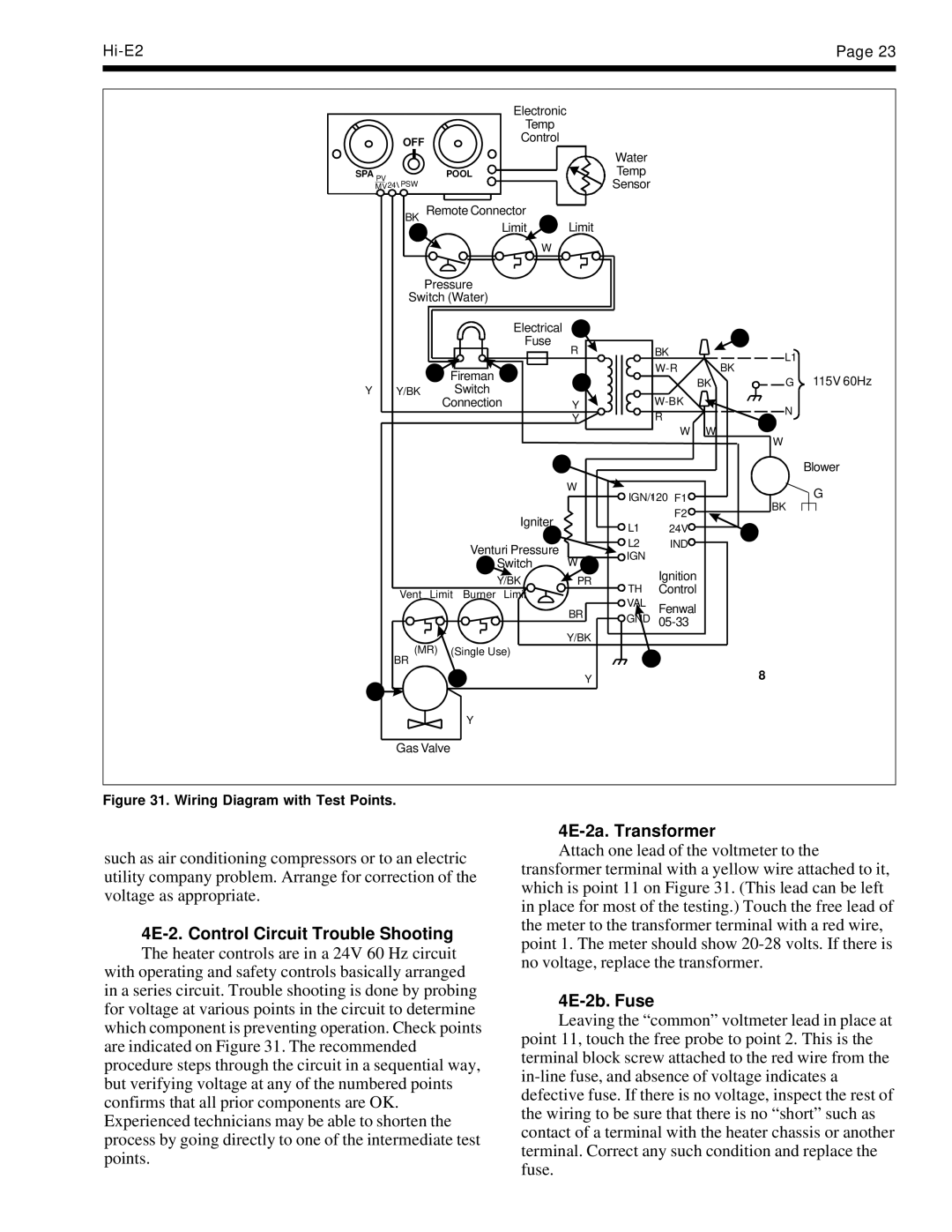
|
|
|
|
|
|
|
|
| Page 23 | |
|
|
| Electronic |
|
|
|
|
|
| |
|
|
| Temp |
|
|
|
|
|
| |
| OFF |
| Control |
|
|
|
|
|
| |
|
|
|
|
|
|
|
|
|
| |
|
|
|
|
|
| Water |
|
|
|
|
SPA PV |
| POOL |
|
|
| Temp |
|
|
|
|
MV 24V PSW |
|
|
|
| Sensor |
|
|
| ||
| BK Remote Connector | 4 | Limit |
|
|
|
|
| ||
| 5 |
| Limit |
|
|
|
|
| ||
|
|
|
|
|
|
|
|
|
| |
|
|
|
| W |
|
|
|
|
|
|
| Pressure |
|
|
|
|
|
|
|
| |
| Switch (Water) |
|
|
|
|
|
|
|
| |
|
|
| Electrical | 1 |
|
|
| A |
| |
|
|
| Fuse | R |
| BK |
|
| ||
|
|
|
|
|
|
| L1 |
| ||
|
|
|
|
|
|
|
|
|
| |
| 3 | Fireman | 2 |
|
|
|
| BK | 115V 60Hz | |
|
| 11 |
|
| BK | G | ||||
Y | Y/BK | Switch |
|
|
|
| ||||
|
|
|
|
|
|
|
| |||
| Connection |
| Y |
|
| N |
| |||
|
|
|
|
| Y |
| R |
|
| |
|
|
|
|
|
|
| B |
| ||
|
|
|
|
|
|
| W | W |
| |
|
|
|
|
|
|
| W |
| ||
|
|
|
|
|
|
|
|
|
| |
|
|
|
| D |
|
|
|
|
| Blower |
|
|
|
|
| W | S120IGN/120 F1 |
|
| G | |
|
|
|
|
|
|
|
| |||
|
|
|
|
|
|
| BK |
| ||
|
|
|
|
|
|
| F2 |
|
| |
|
|
| Igniter |
|
|
|
|
| ||
|
|
|
| L1 | 24V |
| C |
| ||
|
|
|
| E |
|
|
| |||
|
|
|
|
| L2 | IND |
|
| ||
|
| Venturi Pressure |
|
|
|
| ||||
|
|
| IGN |
|
|
|
| |||
|
| 6 | Switch |
| W 7 | S2 |
|
|
|
|
|
|
|
| Ignition |
|
|
| |||
|
|
| Y/BK |
| PR |
|
|
|
| |
|
|
|
| TH | Control |
|
|
| ||
| Vent Limit | Burner Limit |
|
|
|
|
| |||
|
|
| VALMVI |
|
|
|
| |||
|
|
|
|
| BR | Fenwal |
|
|
| |
|
|
|
|
|
|
|
|
| ||
|
|
|
|
|
|
|
|
| ||
|
|
|
|
|
|
|
|
|
| |
| (MR) |
|
|
| Y/BK |
|
|
|
|
|
| (Single Use) |
|
|
| 8 |
|
|
| ||
| BR |
|
|
|
|
|
|
|
| |
10 |
| 9 |
|
| Y |
|
|
| 8 |
|
|
|
|
|
|
|
|
|
|
| |
|
| Y |
|
|
|
|
|
|
|
|
| Gas Valve |
|
|
|
|
|
|
|
| |
Figure 31. Wiring Diagram with Test Points.
such as air conditioning compressors or to an electric utility company problem. Arrange for correction of the voltage as appropriate.
4E-2. Control Circuit Trouble Shooting
The heater controls are in a 24V 60 Hz circuit with operating and safety controls basically arranged in a series circuit. Trouble shooting is done by probing for voltage at various points in the circuit to determine which component is preventing operation. Check points are indicated on Figure 31. The recommended procedure steps through the circuit in a sequential way, but verifying voltage at any of the numbered points confirms that all prior components are OK. Experienced technicians may be able to shorten the process by going directly to one of the intermediate test points.
4E-2a. Transformer
Attach one lead of the voltmeter to the transformer terminal with a yellow wire attached to it, which is point 11 on Figure 31. (This lead can be left in place for most of the testing.) Touch the free lead of the meter to the transformer terminal with a red wire, point 1. The meter should show
4E-2b. Fuse
Leaving the “common” voltmeter lead in place at point 11, touch the free probe to point 2. This is the terminal block screw attached to the red wire from the
